Похожие презентации:
Expropriation. Class 3
1. Mesrop Manukyan
CLASS 3EXPROPRIATION
MESROP MANUKYAN
2. UNDERSTANDING EXPROPRIATION
Expropriation?Scope of expropriation?
Definition of investment?
Definition of investor?
Definition of expropriation?
expropriation may be direct/de jure (when there is a formal
transfer of the title) or indirect/de facto (when the title remains to
the investor but the State acts in such a manner thus impairing
the essence of the investment, to the effect that the investment is
in fact nationalized and deprived of the actual use or enjoyment
of the investor’s benefit). Indirect or de facto expropriation must
be distinguished from non-compensable regulatory action that
has adverse economic results for the investor. Legality?
3. UNDERSTANDING EXPROPRIATION
- Neither BITs, nor NAFTA give a clear definition of acts (orprocesses) that amount to expropriation
- VCLT article 31 § 3 c provides that in order to interpret the
term, recourse shall be had to the relevant norms of
international law applicable between the parties. These
norms may refer to treaties, customs and general
principles of law. Many scholars have sought to make a
comparative analysis of the various legal systems of
municipal law in order to infer general principles on the
law of expropriation
- As Rudolf Dolzer suggests, expropriation remains to a large
extent rough and sketchy and there are still significant
lacunae in its definition under international law
4. UNDERSTANDING EXPROPRIATION
Indirect and direct expropriation?Indirect expropriation and non-compensable regulatory
action?
How to distinguish between all of these actions? What to
look at?
5. DIRECT EXPROPRIATION
Direct (overt) expropriation supervenes when the Stateproceeds to an open, deliberate and acknowledged
taking of property, such as outright seizure or formal or
obligatory transfer of the formal title of ownership over the
investment or when the investor is legally coerced to
transfer its title to the State itself or a third party (Metalclad
v. Mexico, §103)
Rarely happens
Negative publicity
Indirect measures are more common
6. INDIRECT EXPROPRIATION
As a general rule, indirect (covert, incidental, creeping, defacto) expropriation supervenes when the State interferes
with the use of property without taking the formal title
thereof and has an effect equivalent to direct
expropriation, because it deprives the owner, in whole
OR in significant part of the use
OR reasonably to be expected benefit of property, even
when if this is not necessarily to the obvious benefit of the
State (Metalclad, §103)
7. NON-COMPENSABLE REGULATORY ACTION
Difference with indirect expropriation?- Clash of interests of investor and state
- the community cannot reasonably be expected to bear
the normal commercial risks associated with investments
- Foreign investors cannot conduct themselves in a manner
detrimental to the general welfare (SD Myers c. Canada)
- On the other hand, investors cannot be expected to bear
and pay risks that should be socialized
- Nonetheless, not every measure that affects the
economic value of the investment or its profitability
amounts to an expropriation
8. NON-COMPENSABLE REGULATORY ACTION
Police powers doctrine- Under customary international law, a State has the right to
regulate or take other measures (administrative etc.) in
order to protect the general welfare interests of the
community
- Tecmed v Mexico - the Tribunal held that the principle,
according to which ‘the State ’s exercise of sovereign
powers within the framework of police power may cause
economic damage to those subject to its powers as
administrator, without entitling them to any compensation
whatsoever, us undisputable’ (§119)
- What do you think?
9. NON-COMPENSABLE REGULATORY ACTION
Police powers doctrine- Feldman v Mexico - the Tribunal noted that (§ 112) ‘not all
government regulatory activity that makes it difficult or
impossible for an investor to carry out a particular business,
change in the law or change in the application of existing laws
that makes it uneconomical to continue a particular business, is
an expropriation under Article 1110 NAFTA
- ‘governments must be free to act in the broader public interest
through protection of the environment, new or modified tax
regimes, the granting or withdrawal of government subsidies,
reductions or increases in tariff levels, imposition of zoning
restrictions and the like. Reasonable governmental regulation of
this type cannot be achieved if any business that is adversely
affected may seek compensation, and it is safe to say that
customary international law recognizes this’.
10. NON-COMPENSABLE REGULATORY ACTION
How to draw the line?The International Law Commission in its 36th Conference in 1930 in
New York defined that States are not liable to pay compensation
under certain criteria. Those criteria are:
1. When the State acts in the normal exercise of police powers
and the measure falls within the ambit of its powers: according to
Black’s Law Dictionary, police powers stem from national
sovereignty and confer to the sovereign the right to enact all laws
necessary and appropriate to protect a legitimate public interest
(public order, safety, health, morals and justice).
2. When the measure is enacted in the interests of public welfare:
this is a criterion inherent in the concept of ‘police powers’. In the
last years, the most significant arbitral cases concerned the clash
between investors’ interests and environmental policies.
11. NON-COMPENSABLE REGULATORY ACTION
3. When the measure is not discriminatory and of a generalnature: the measure must be generally applicable to the
entire community and not targeted against a specific
investor. E.g. the Harvard Draft Convention for the
International Responsibility of States for Injuries to Aliens
(Prof. Baxter) defines as non-compensable the taking of
alien property or a deprivation of use, which results from:
general taxation, general change in currency, action
taken to maintain public order, health or morals.
4. When the measure is taken bona fide.
12. NON-COMPENSABLE REGULATORY ACTION V EXPROPRIATION
3 approaches:1. Sole-effect approach
2. Purpose approach
3. Contextual approach
13. SOLE EFFECT APPROACH
- attaches particular weight to the effects of the impugnedmeasure on the investment/investor, in particular the
degree or intensity of the measure and the frustration of
the investor
- If the regulatory action is far too restrictive (regardless of
its purpose and the public welfare it serves), it is
tantamount to an expropriation
- Public welfare objective and purpose are irrelevant
Is this acceptable?
14. SOLE EFFECT APPROACH
- In Trippetts v. TAMS AFFA, the Tribunal held that: ‘the intentof the Government is less important than the effects of the
measure on the owner and the form of the measures is
less important than the reality of their impact’.
- The sole-effect test was explicitly upheld in Metalclad,
where the Tribunal held that ‘it is not necessary to decide
or consider the motivation of the adoption of the
Ecological Decree.’
15. SOLE EFFECT APPROACH
- Santa Elena SA v Republic of Costa RicaThe case concerned a direct, de jure expropriation order issued
by Costa Rica with respect to the assets of US national investors
that had the majority of shares in a Costa Rican company. Both
the parties agreed that the expropriation was lawful. The
contentious issue, however, was the determination of the amount
of compensation due to the claimant.
In particular, Costa Rica contented that its obligation to pay
damages should be set aside, due to the fact that it was obliged
to conform to different international obligations to preserve and
protect the environment and the unique ecology of the area in
which the Santa Elena property was situated, by expropriating it
and incorporating into a national park. Costa Rica adduced
detailed evidence as to its international environmental
obligations.
16. SOLE EFFECT APPROACH
- Santa Elena SA v Republic of Costa Rica- the Tribunal noted that the purpose of the expropriation
does not affect the obligation to compensate the owners
of the assets expropriated
- ‘while expropriation or taking for environmental reasons
may be classified as a taking for public purpose and thus
may be legitimate, the fact that the Property was taken for
this reason does not affect either the nature or the
measure of the compensation to be paid for the taking
- the purpose of protecting the environment, for which the
Property was taken, does not alter the legal character of
the taking for which adequate compensation must be
paid
17. SOLE EFFECT APPROACH
The sole effect approach is further divided into the(i) effects on the investment and
(ii) effects on the investor:
18. SOLE EFFECT APPROACH
Effects on investment- the arbitral Tribunal will have to assess whether the
impugned measure was so restrictive and burdensome,
that it deprived the investor of all substantial economic
benefit and use of its property thus rendering the
investment economically useless, for the investor had no
other reasonable alternative, in order to exploit and make
profit out of its property assets
- Effect on property rights
19.
CriteriaAuthority
1.Unreasonableness
American Law Institute, Restatement of the Law – Third, The
Foreign Relations of the USA, 1987: When the regulation
‘prevents, unreasonably interferes with or unduly delays the
effective enjoyment of an alien’s property’
2. When the interference ‘renders the rights
so useless, that it must be deemed to have
been expropriated, even if the State ’
Starrett Housing Corp v. Iran.
3. When the interference deprives the
investor from the ‘fundamental rights of
ownership and the deprivation is not
ephemeral’
Award Tippets v. TAMS-AFFA.
the claimants were a group of companies that made a large
investment in a housing project in Tehran. Through a
‘revolutionary decree’, the Iranian Government appointed a
manager that had the power to direct on behalf of the
government, the entire project. The Tribunal found that the
investors were effectively deprived of their right to manage their
property [effective use & enjoyment of their property] and thus
there was an expropriation.
the claimants were an American consultant enterprise that had
a 50% interest in a Partnership with an Iranian engineering
enterprise, established for the purposes of constructing the
Tehran International Airport. The partnership was managed by a
4-members committee, each partner appointed 2. Following the
revolution in Iran, the government appointed a temporary
manager that had the power to sign checks and make
managerial decisions contrary to the will of the investors. The
Tribunal found that the investors were deprived of the
fundamental rights of ownership.
20.
CriteriaAuthority
4. When the interference is ‘sufficiently
restrictive to support that the property has
been ‘taken’ from its owner’.
NAFTA Award Pope & Talbot c. Canada
5. ‘covert or incidental interference with the
use of property which has the effect of
depriving the owner, in whole or in
significant part of the use or reasonably-tobe-expected economic benefit of the
property ’
Award NAFTA, Metalclad v. United Mexican States
the claimant was an American corporation that invested in a Canadian
subsidiary company that manufactured and exported softwood. In 1996,
Canada signed an agreement with the US on Lumber. In conformity with the
Agreement, Canada issued domestic regulation that restricted softwood
exports from Canada to the US. The company claimed that it had been
expropriated, because it was deprived of its ordinary ability to sell its products
in its traditional market (the US). The Tribunal held that the test to be applied is
the restrictiveness of the regulatory measure and dismissed the claimants’
contentions: indeed the measure may have been restrictive, but the investors
still had the ability to control their investment, export substantive quantities and
make profit. Thereby, the measure was not sufficiently restrictive to be deemed
as expropriation.
A landmark case: the only one where an expropriation was found under
NAFTA. The case was about a US corporation that had invested in Mexico
through a locally incorporated subsidiary. The project was about the
development and operation of a hazardous waste landfill. The Government
had reassured the investor that all the required permits had been collected.
After the construction project had been effected, the operation could not
begin because the municipal authorities refused to issue a municipal permit on
the grounds that it would have negative environmental impact. The Tribunal
concluded that the interference was absolute, as it prevented the investor
from a meaningful return of its investment and was equivalent to expropriation.
Mexico was condemned to pay $17 million. The award was later put aside by
the Columbia Supreme Court for different reasons.
21.
CriteriaAuthority
6. Loss of effective control over the use or
disposition of substantial portion of property
Award, Revere Copper v. OPIC, 24 August 1978
7. Effective neutralisation of the property
benefits
Award, CME v. Czech Republic (UNCITRAL)
Revere Copper had made a substantial commitment of investment in
Jamaica in the bauxite mining sector. Following an agreement
between the investor and the Jamaican Governent, taxes and
royalties had been fixed for a period of 25 years and no further burdens
would be applied to the investment. In 1972, the newly elected
Government announced far reaching reforms in bauxite sector and
increased revenues so much that the investor ceased operating in
1975. Revere Copper sought for compensation by the Insurance
Company, OPIC, alleging that the measures taken amounted to
‘expropriation’ under the insurance contract. The Tribunal held that
although there had been no physical taking of his property, the
repudiation of the guarantees given to the investor had resulted into
‘preventing the enterprise from exercising effective control over the use
or disposition of substantial portion of its property’.
the case is about the claimant’s argument that the Media Council’s
actions that had made possible for the investor’s local partner to
cancel the contract that formed the basis for the investment. The
Respondent replied that there had been no physical taking of the
property, thus no expropriation. The Tribunal rejected the argument:
‘the Media Council’s actions and omissions caused the destruction of
CNTS’s operations, leaving it a company with assets, but without
business…what was destroyed was the commercial value of the
investment by reason of coercion…de facto expropriations i.e.
measures that do not involve an overt taking but that effectively
neutralise the benefit of the property are subject to expropriation claim.
This is not disputed under international law.’
22. SOLE EFFECT APPROACH
Effects on investorWhat to consider here?
(a) Legitimate expectations. How?
(a) Usually for FET standard
(b) Normal business risks Starrett Housing v Iran
(b) Control over the investment / enterprise. How?
(a) Finding loss of control Pope Talbot v Canada – there must be
total or substantial deprivation
(b) when the investor does not lose the entire control over the
investment, but rather retains some control over the overall
investment, albeit deprived of specific rights, several Tribunals
have rejected a finding of expropriation in this scenario (Feldman,
Occidental Ecuador, CMS v. Argentina, Enron v. Argentina, AES v.
Hungary FET
(c) Measuring loss of control (a) Sufficiently affected, (b)
diminution of value (%)
23. PURPOSE APPROACH
- Looks on the purpose of measure- if the measure serves a legitimate public purpose (the
environment, public order, public safety, morals), then this
purpose, in and of itself, is enough to cast the measure as
being in the realms of police powers and hence noncompensable, regardless of the magnitude of its effect
on the investment
- known as the approach ‘which treats police powers as an
exception from expropriation because it conflates lawful
expropriation with police powers: all the expropriations
that are done with a public purpose shall not be
compensable
- Acceptable?
24. PURPOSE APPROACH
- In the case of Methanex Corporation v. the United States, Methanexclaimed that it had been directly expropriated under Article 1101 of the
NAFTA. The Tribunal dismissed its claims stating establishing the following:
- ‘an intentionally discriminatory regulation against a foreign investor fulfils a
key requirement for establishing expropriation.
- But as a matter of general international law, a non-discriminatory regulation
- for a public purpose,
- which is enacted in accordance with due process and,
- which affects, inter alios, a foreign investor or investment is not deemed
expropriatory and compensable
- UNLESS specific commitments had been given by the regulating
government to the then putative foreign investor contemplating investment
that the government would refrain from such regulation’ (in the sense of
legitimate expectations). In the same judgment: “[i]t is a principle of
customary international law that, where economic injury results from a bona
fide regulation within the police powers of a Stat , compensation is not
required”
25. PURPOSE APPROACH
Sea Land Service Inc. v. Iran- ‘A finding of expropriation would require, at the
the Tribunal be satisfied that there was
governmental interference with the conduct
operation, the effect of which was to deprive if
benefit of the investment.’
very least, that
a deliberate
of Sea-Land’s
of the use and
Phillips Petroleum Co Iran v. Iran - emphasized that “a
government’s liability to compensate for expropriation of alien
property does not depend on proof that the expropriation was
intentional”!!!
Feldman v. Mexico - this is out rightly rejected in §98: ‘If there is a
finding of expropriation, compensation is required, even if the
taking is for a public purpose, non-discriminatory and in
accordance with due process of law’.
26. CONTEXTUAL APPROACH
- The third approach weighs both the purpose and theeffects of the measure in a ‘regulation/expropriation
equation’:
the higher the purpose of a measure and the greater
the practical benefits to the community, the greater the
impact that has to be demonstrated on the interference.
Conversely, the higher the magnitude of interference,
the more compelling and convincing public objectives
have to be adduced to justify it. The parameters of the
contextual approach are various and need a cautious
integral assessment.
27. CONTEXTUAL APPROACH
Saluka v Czech Republic‘international law has yet to identify in a comprehensive and
definitive fashion precisely what regulations are considered
“permissible” and “commonly accepted” as falling within the police
or regulatory power of States and, thus, non-compensable. In other
words, it has yet to draw a bright and easily distinguish-able line
between non-compensable regulations on the one hand and, on
the other, measures that have the effect of depriving foreign investors
of their investment and are thus unlawful and compensable in
international law’ (§263). ‘It thus inevitably falls to the adjudicator to
determine whether particular conduct by a State “crosses the line”
that separates valid regulatory activity from expropriation. Faced
with the question of when, how and at what point an otherwise valid
regulation becomes, in fact and effect, an unlawful expropriation,
international Tribunals must consider the circumstances in which the
question arises. The context within which an impugned measure is
adopted and applied is critical to the determination of its validity.’
(§264).
28. CONTEXTUAL APPROACH
SD Myers v CanadaTribunal shall take into account the public welfare
objective or the emergency pursued by the measure, its
duration, its effects, as well as the character of the
measure, in a proportionality analysis.
What is proportionality analysis? How to implement?
29. CONTEXTUAL APPROACH
1. Defining the problem- even if the regulatory measure is fully legitimate (from a
public policy perspective) and non-discriminatory, is there
a breaking point, below which no compensation is due
(because it simply affects negatively the economic value
of the investment) and above which compensation is due,
because individuals are required to make a special
sacrifice in terms of proprietary rights?
30. CONTEXTUAL APPROACH
2. Definition of proportionality• Legitimacy: at a preliminary stage, the measure must
pursue the public good as spelt out in a public welfare
objective. This filters out illegitimate or impermissible
purposes.
• Suitability: the measure must be able to attain the
legitimate purpose to which it is avowed.
• Necessity: the measure must be the less restrictive means
in view of its final ends.
• Strict proportionality: it requires the court to weight the
two competing interests and arrive at a conclusion
whether the benefits stemming from the measure are
proportionate to the harm inflicted to the right/interest at
stake through a cost/benefit analysis.
31. CONTEXTUAL APPROACH: SUMMARY
In accordance with the principle of proportionality:a general, non-discriminatory regulatory measure,
enacted bona fide by the State
for the interests of protecting a public welfare objective falling in the
remit of ‘police powers’ under customary international law, may,
notwithstanding its purpose and character, be tantamount to
expropriation (and re-quire adequate compensation) IF,
the measure in question, notwithstanding its qualitative characteristics,
is disproportionate to the legitimate aim pursued, BECAUSE the latter could
have been achieved with less restrictive measures that would not have been
expropriatory on the investor.
Total S.A. v. Argentina: ‘legitimate, proportionate, reasonable and nondiscriminatory legislative measures would not be held to be expropriatory’, §
197.
El Paso v. Argentina: ‘general regulatory measures would not amount to
indirect expropriation unless they are unreasonable, arbitrary, discriminatory,
disproportionate or otherwise unfair’, §§241, 243.
32. CONTEXTUAL APPROACH: PRACTICE
S.D. Myers v. Canada (NAFTA), was a case that concerned theapplication of an export ban on PCB exports to the US. PCB is a toxic
substance both for humans and animals. Since 1970, both the US and
Canada banned the manufacture of PCB. In 1980 the US closed its
borders to PCB (ex-ports/imports), with the exception of imports
where approval was granted by the Environmental Protection
Agency (EPA). Conversely, Canada also banned exports of PCB, with
the exception of PCB exported to the US, upon approval of the EPA.
An American corporation took advantage of this legal framework in
order to invest in the PCB exports. It created a subsidiary company in
Canada (SD Myers), conveniently located in the borders between
the US and Canada. Its main operation was to extract PCB from
contaminated equipment and destroy the isolated PCB in the US. In
1995, the Canadian Minister of Environment issued a ban on the
commercial export of PCB waste for disposal. Subsequently, the Ban
was lifted two years later, in 1997. The claimant held that the Order
was an indirect expropriation as it deprived the investor of a
meaningful control over its assets.
33. CONTEXTUAL APPROACH: PRACTICE
Tribunal focused on the effect of the measure, noting that the purpose thereof wasalso relevant to the question of expropriation. Ιn §281, ‘the Tribunal accepts that, in
legal theory, rights other than property rights may be “expropriated” and that
international law makes it appropriate for Tribunals to examine the purpose and
effect of governmental measures’. As to the purpose, the Tribunal held that the
ban on the export was not, in reality, imposed for environmental purposes but was
a thinly-disguised protectionist trade measure (§ 162). In §282, the Tribunal seems to
imply proportionality between purpose and effect: ‘expropriations tend to involve
the deprivation of ownership rights; regulations a lesser interference.’ But a relevant
factor in the balancing exercise is the duration of the measure. In §283 the Tribunal
stressed: ‘An expropriation usually amounts to a lasting removal of the ability of an
owner to make use of its economic rights although it may be that, in some contexts
and circumstances, it would be appropriate to view a deprivation as amounting to
an expropriation, even if it were partial or temporary’. In the instant case, however,
the closure of the border was temporary (only 18 months). In view of the limited
duration of the interference, the measure was not “tantamount to an
expropriation” under NAFTA (§§ 285, 287). What is most interesting in this case is
§221, where the Tribunal underlined that where a where a State can achieve its
chosen level of environmental protection through a variety of equally effective
and reasonable means, it is obliged to adopt the alternative that is most consistent
with open trade, citing the case-law of the WTO. This may be seen as a first form of
expression of proportionality.
34. CONTEXTUAL APPROACH: PRACTICE
In Feldman v. Mexico the complainant was a US National natural person, Mr.Feldman, who owned a Mexican subsidiary company in Mexico. The
complainant claimed that the refusal of Mexico to rebate excise taxation on
the cigarettes exported by the company was tantamount to ‘expropriation’
under NAFTA. Τhe Tribunal acknowledged that ‘no one can seriously question
that in some circumstances government regulatory activity can be a violation
of Article 1110’ (§110).
Nonetheless, ‘not all regulatory activity that makes difficult or impossible for an
investor to carry out a particular business, change in the law or in the
application of existing laws, that makes it uneconomical to continue a
particular business, is an expropriation.’ The Tribunal dismissed the applicant’s
claim. Taking into account the purpose and effect of the measure, it held that
there was no expropriation (§§111, 112). The case is important because the
Tribunal holds that a regulatory measure that ‘unreasonably interferes with…’
the investor’s property, might be expropriatory (§§ 103, 105). The
measurement of ‘reasonableness’ is the conceptual predecessor of
proportionality in in-vestment Tribunal’s reasoning.
35. CONTEXTUAL APPROACH: TECMED
in TECMED, the investor was a Spanish parent company that investedin a Mexican subsidiary, Cytrar. The main operation of the investment
was a hazardous waste disposal facility in a rapidly expanding urban
area of Mexico. Following fierce community opposition against the
location of Cyrtar facilities, the authorities entered into an agreement
in order to relocate the facility. Although the new location could be
found within a relatively small time frame, the authorities refused to
renew the permit of the facility and ordered Cyrtar to cease its
operations immediately (despite the fact that the new location had
not been secured). As an effect, the investor could no longer
continue operations or use the specific site for other purposes, due to
the accumulation of hazardous material. Mexico argued that the
actions taken were enacted with the objective of protecting the
environment and public health, but the Tribunal stressed that this was
a mere pretext and the true purpose was the community pressure on
the government, rather than the breach of the permit’s conditions for
environmental reasons.
36. CONTEXTUAL APPROACH: TECMED
The claim and response: the main contention of theclaimant was that the non-renewal of the permit of the
Landfill through the Resolution of November 1998 caused
damage and expropriated its investment in an indirect
expropriation. Without such permit, the property would
have no individual or aggregate market value and the
existence and function of the investment were completely
destroyed following the refusal. The Government refused
this contention; it claimed that it had the discretionary
power to grant and deny permits and that the denial of
permit was a non-discriminatory measure enacted within
the State ’s police power to regulate and extremely
sensitive framework of environmental protection and public
health. As such, it did not amount to an expropriation.
37. CONTEXTUAL APPROACH: TECMED
the Tribunal oscillated between the sole-effects and thecontextual approach:
Sole effect. In § 116, the Tribunal notes: the measures adopted
by a State , whether regulatory or not, are an indirect de facto
expropriation if they are irreversible and permanent and if the
assets subject to such measures have been affected in such way
that any form of exploitation has disappeared. Nonetheless, “the
government’s intention is less important than the effects of the
measures on the owner of the assets; and the form of the measure
is less important than its actual effects.” Hence, the Tribunal held
that from a sole-effects perspective, the decision of Mexico can
be deemed as expropriatory under Article 5(1) of the Agreement
(§117).
38. CONTEXTUAL APPROACH: TECMED
Contextual approach. quite surprisingly, however, in §118, theTribunal ‘deems it appropriate to examine…whether the
Resolution, due to its characteristics and considering not only its
effects, is an expropriatory decision’. But this is quite unclear. The
Tribunal does not explain the logical relationship between the
characteristics and the effects in order to assess the
expropriatory character of a measure.
§122 - ‘the Tribunal will consider, in order to determine if they
are to be characterised as expropriatory, whether such actions
or measures are proportional to the public interest presumably
protected thereby and to the protection legally granted to
investments, taking into account that the significance of such
impact has a key role upon deciding the proportionality’
39. CONTEXTUAL APPROACH: TECMED
Hence, ‘there must be a reasonable relationship ofproportionality between the charge or weight imposed to
the investor and the aim sought to be realized by any
expropriatory measure. To value such weight, it is very
important to measure the size of the ownership deprivation
caused … whether such deprivation was compensated or
not. On the basis of a number of legal and practical
factors, it should be also considered that the foreign
investor has a reduced or nil participation in the taking of
the decisions that affect it, partly because the investors are
not entitled to exercise political rights reserved to the
nationals of the State , such as voting the authorities that
will issue the decisions.
40. CONTEXTUAL APPROACH: TECMED
- Effects of measure: It is crucial to examine whether the person was stripped of theenjoyment of its property assets and whether the economic value thereof has
been destroyed or substantially decreased. The effects of the measure have a ‘key
role’ in the final judgment, but not an exclusive one.
- Public purpose: The Tribunal shall also assess the measure in light of its public
purpose and its purported legitimate aim.
- Reasonable policy: The authorities shall be allowed ‘due deference’ in forming
their policies, but that does not impede the Tribunal from examining whether the
reasonable test has been observed.
- Relationship of proportionality: Between the measure and the aim there must be a
reasonable relationship of proportionality: the measure must be appropriate to
achieve its aim, the less restrictive among the available appropriate means and
must be reasonable and proportionate to the final end, in the sense that it must not
place an excessive individual burden on the investor. The case seems to set a
stringent review of proportionality and allow a high threshold of reasonableness in
the relation-ship between the measure and its end.
- Various factors: Various factors that have to be weighted are: the duration of the
measure, the size of the deprivation, whether the investor received any
compensation at all, the legitimate expectations of the investor and his limited
participation in the decision-making process.
41. TECMED
Do you agree with the tribunal’s reasoning?Criticism (1) no examination of legitimacy, suitability and
necessity; (2) subjectivity and facts; (3) ECHR case law, (4)
very strict scope of police powers doctrine





















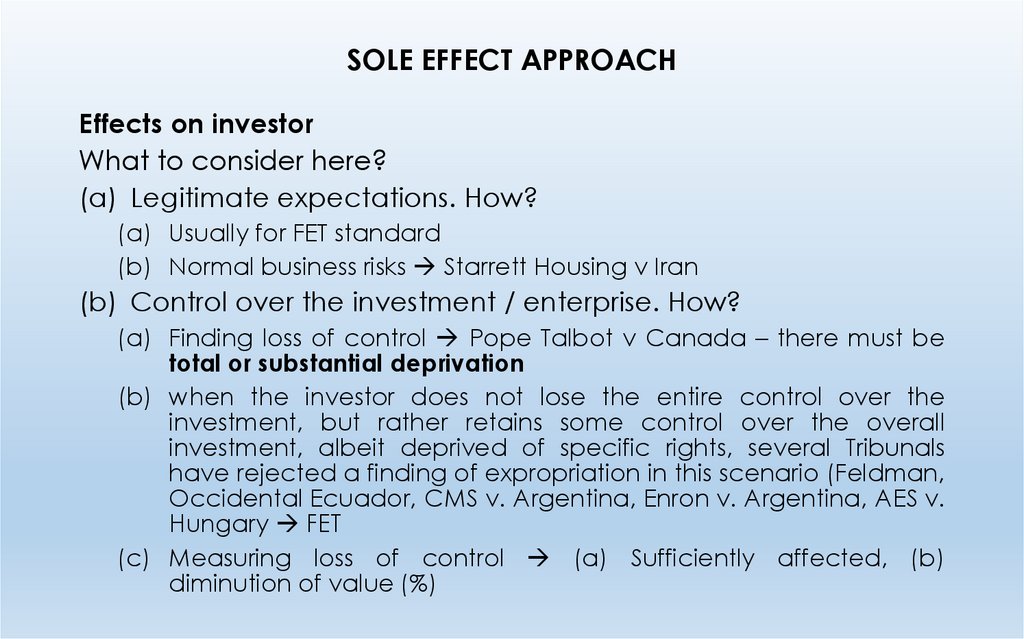




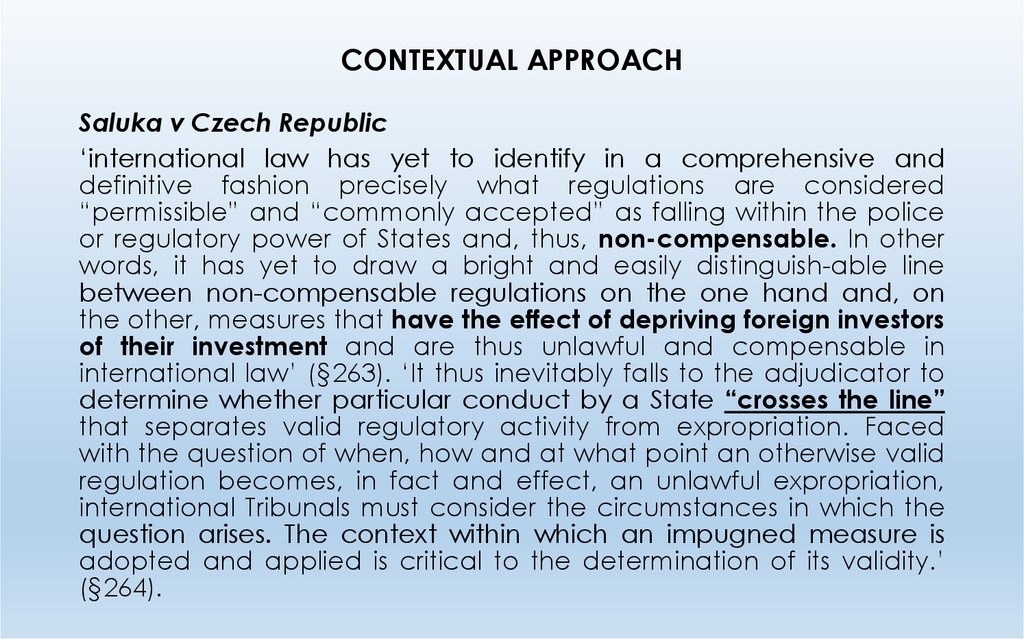



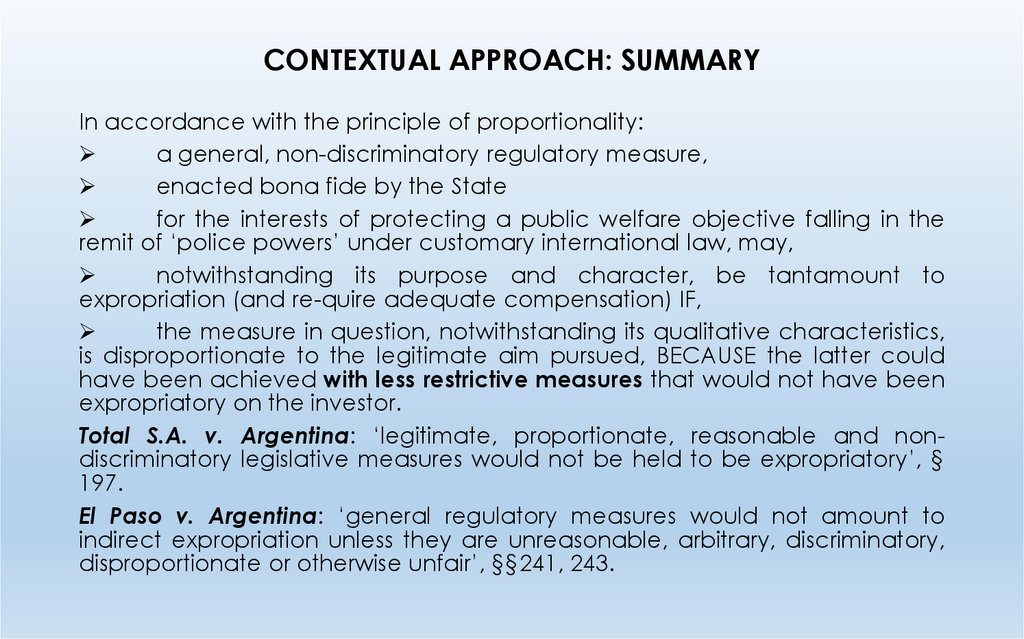


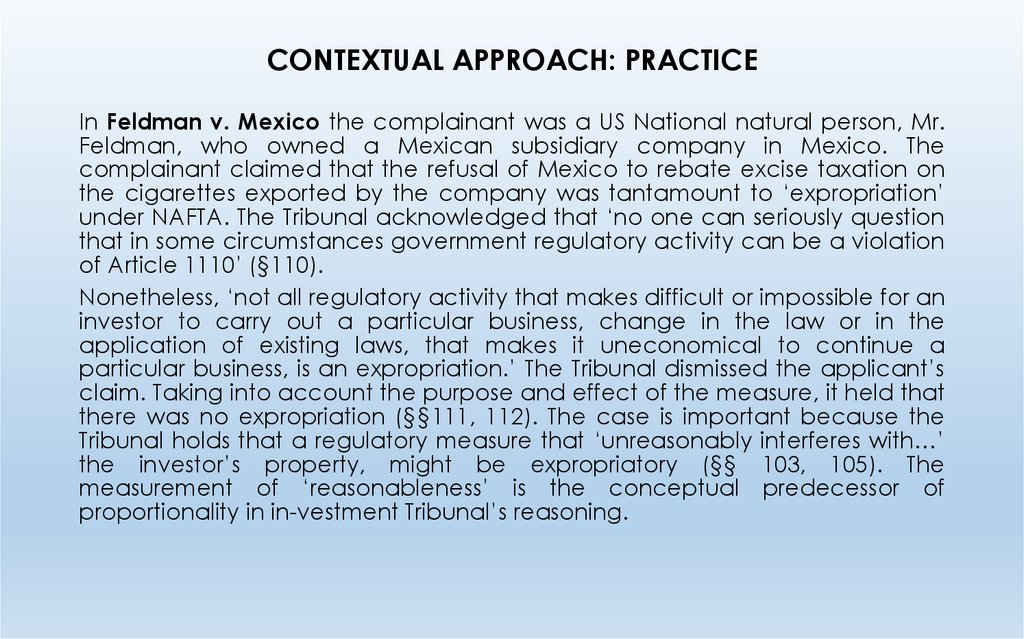
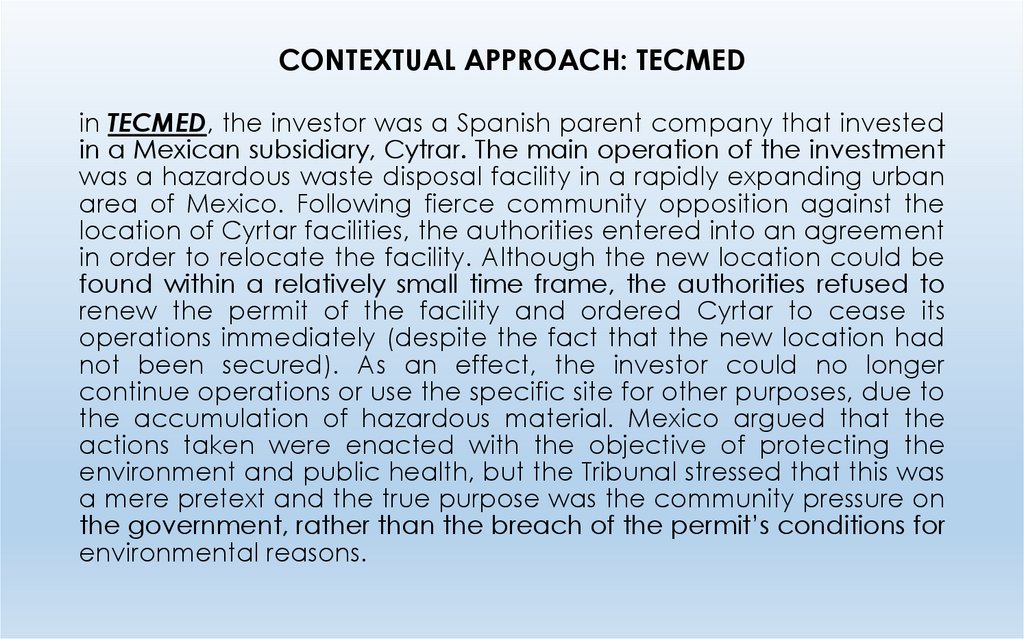





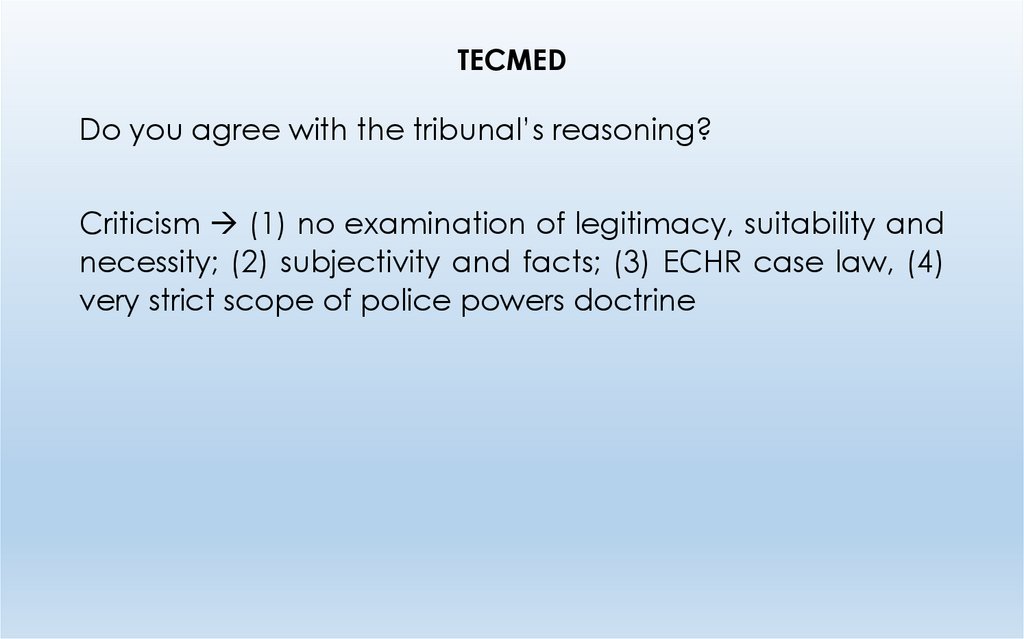

 Экономика
Экономика








